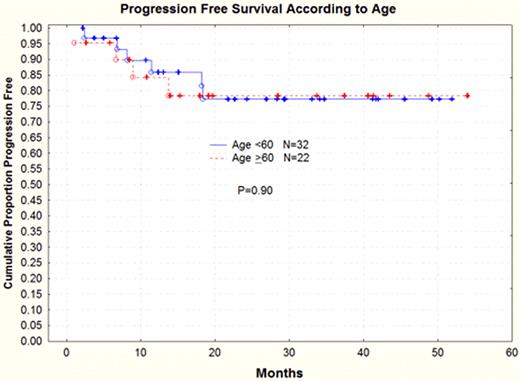Abstract
Abstract 2789
Standard front line therapy for large B cell lymphoma is R-CHOP every 21 days. However, a randomized study by Pfreundschuh comparing CHOP every 21 vs. CHOP every 14 days showed an advantage in favor of CHOP-14 (Pfreundschuh et al. Blood 104:626–33, 2004). Growth factor support is necessary in CHOP-14. Preclinical studies have shown that low dose GM-CSF augments the effect of Rituximab by enhancing various effector functions such as ADCC and upregulation of CD 20 antigen expression. We proposed to investigate in a phase I-II study, the standard combination of CHOP-Rituximab plus PEG-Filgrastim (PEG-F, Neulasta..), and a short course of GM-CSF (Leukine..). Rituximab 375 mg/m2 was given on day 1, CHOP on day 2. The phase I portion had shown that PEG-F at 4 mg SC on day 3 combined with a short course (4 doses) of GM-CSF 250 mcg given on days 6, 8, 10 and 13 was capable of supporting recovery from myelosuppression so as to allow repetition of chemotherapy cycles every 14 days (Cabanillas et al. JCO. 25: abstr 18501, 2007). We now report the results of the antitumor activity of this combination, which was designed to generate preliminary pilot data as to the effectiveness in regards to complete response (CR) rate and event free survival (EFS).
We had proposed in the protocol a CR rate of >50%, using the modified IWC criteria which includes FDG-PET scan, as interesting enough to justify a larger study to be planned for the future. As an additional endpoint, EFS at 2 years was also included. Between January 2006 and June 2010, a total of 59 pts of a planned accrual of 60 pts, with previously untreated aggressive NHL have been enrolled. Eligibility criteria included age>18 (no top age limit), stages I-IV NHL, HIV negative. A total of 6 courses of CHOP-R-Peg-F-GM-CSF every 14 days were planned.
54 patients (pts) are currently evaluable and 5 too early. Among these patients, histologies were: DLCL-B= 83%, Follicular grade 3= 8%, others 9%. Risk factors were distributed as follows: median age 56 (25-87); 40% were > 60 years, IPI ≥ 3 =30%, Stage III-IV= 54%. Metabolic CR rate (by PET criteria) was 88%. Pts < 60 years of age (y/o) had a CR rate= 91% vs. 82% for ≥ 60 y/o. At a median follow up of 27 months, 3 yr progression free survival (PFS) was 77%, EFS was 74% and 3 yr overall survival (OS) 76%. No pts have relapsed beyond 18 months. Pts < 60 y/o had 3 yr EFS of 77%, while those older than 60 y/o had EFS of 71%, p=0.42. Pts > 60 y/o had an OS at 3 yrs= 65%, while pts < 60 y/o had a OS= 85%, p=0.18. Pts with IPI > 3 had 3 yr PFS= 61% and EFS of 58% as compared with low IPI who had a PFS= 83%, EFS of 81%, p=0.11. Febrile neutropenia occurred in 7 pts and toxic death in 1 pt. Grade 3/4 leukopenias at any cycle were present in 44 pts (grade 3=19, and grade 4=25) and grade 3 anemia in 8 pts.
R-CHOP-14-GMCSF-Peg-F achieved a CR of 88% which surpassed the planned primary endpoint which had been set at 50%. In an unplanned subset analysis, for the first time we have noticed the same outcome in pts ≥ 60 and <60 y/o (Fig. 1). This could mean that treatment has erased age as an adverse prognostic factor, possibly suggesting a favorable impact of GM-CSF on pts ≥60 y/o. A randomized trial in this particular age group is justified to test this hypothesis.
Cabanillas:Bayer Pharmaceuticals: Research Funding; Genentech: Research Funding. Off Label Use: Leukine,neutrophil recovery for NHL, and possible augmentation of rituximab effect. Rivera:Genentech: Stocks.
Author notes
Asterisk with author names denotes non-ASH members.


